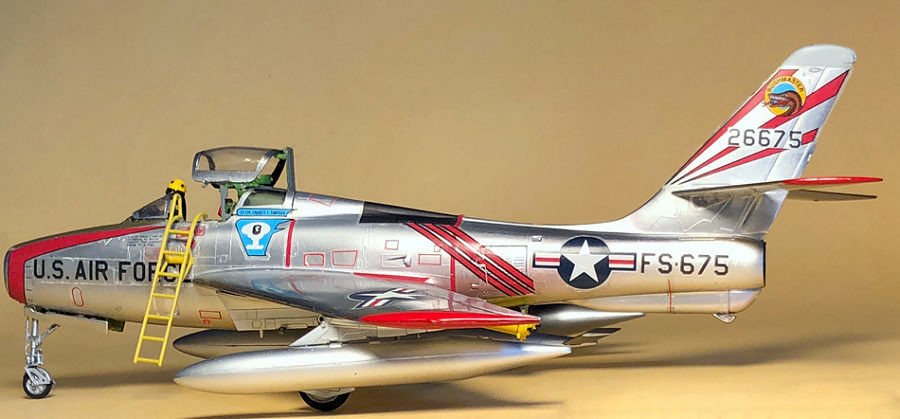
Monogram 1/48 F-84F Thunderstreak
| KIT #: | 5437 |
| PRICE: | $10-15.00 'used' |
| DECALS: | One option |
| REVIEWER: | Blair Stewart |
| NOTES: |
Includes
JATO, nuclear weapon, and weapon cart. |

| HISTORY |
The F-84F Thunderstreak was Republic Aviation’s swept-wing answer to North American’s highly successful F-86 Sabre. Republic began evaluating the concept in 1949 by mating a pair of swept wings to a straight-wing F-84E Thunderjet. The aircraft was first designated the YF-96A, and Republic was somewhat disappointed with the its initial performance. But because of the breakout of the Korean War in 1950, Republic continued the Thunderstreak’s development under the new designation of YF-84F.
The aircraft was then redesigned around the Curtiss-Wright J-65 engine, which was a licensed built version of the British Armstrong-Siddeley Sapphire engine. But Republic ran into both design (i.e., control and stability problems) and production tooling issues (the F-84F used press-forged wing spars and ribs. At the time, only three presses in the United States could manufacture these, and priority was given to the Boeing B-47 Stratojet bomber over the F-84F). thus, the first production F-84F did not fly until late November 1952.
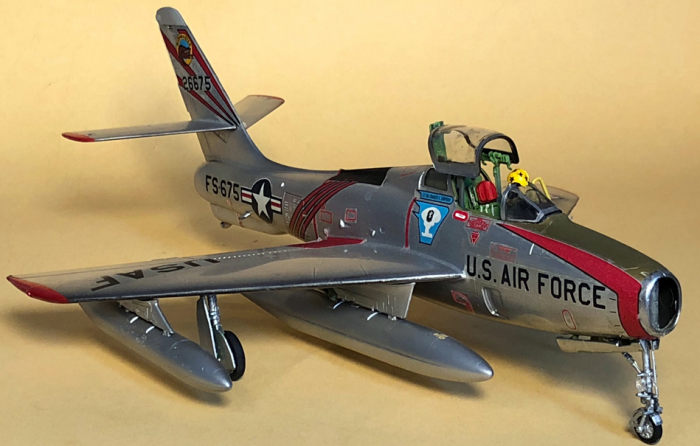 Once operational, the F-84F first served in Strategic
Air Command as a long-range escort fighter for SAC’s B-36 bomber force. But once
SAC converted the force to the eight-jet B-52, it sent its Thunderstreaks to the
USAF’s Tactical Air Command. NATO nations began receiving the F-84F in 1955
through the US Military Assistance Program. The Thunderstreak served with TAC
until the F-100 came along in 1958, at which time they were relegated to the Air
National Guard. But during the 1961 Berlin Crisis, the Air Force reactivated the
F-84F fleet, and they remained in service until 1964. The last Air National
Guard F-84Fs were scrapped in 1971 due to structural corrosion problems.
Once operational, the F-84F first served in Strategic
Air Command as a long-range escort fighter for SAC’s B-36 bomber force. But once
SAC converted the force to the eight-jet B-52, it sent its Thunderstreaks to the
USAF’s Tactical Air Command. NATO nations began receiving the F-84F in 1955
through the US Military Assistance Program. The Thunderstreak served with TAC
until the F-100 came along in 1958, at which time they were relegated to the Air
National Guard. But during the 1961 Berlin Crisis, the Air Force reactivated the
F-84F fleet, and they remained in service until 1964. The last Air National
Guard F-84Fs were scrapped in 1971 due to structural corrosion problems.
One role for the F-84F during the Cold War was to carry the Mark 7 tactical nuclear weapon. The Mark 7 was a variable yield fission weapon (i.e., “atomic” versus “thermonuclear”) with yields ranging from 8 to 61 kilotons. The yield was selected by using different nuclear pits in the warhead inside the bomb casing. For aircraft like the F-84F, the Mark 7 was fitted with one retractable vertical stabilizer fin that allowed it to fit better underneath the aircraft’s wing (Note: aircraft as small as the Navy’s A-4 Skyhawk also carried this weapon). The bomb weighed about 1600 pounds and had selectable airburst and contact fuzing modes.
When fully loaded with gas/drop tanks and the Mark 7 bomb, the under-powered F-84F required a 10,000 foot runway. For shorter runways, the USAF would use jet-assisted takeoff (JATO) bottles strapped to the underside of the fuselage.
| THE KIT |
Originally released in
1984 (kit No. 5432), Monogram’s F-84F Thuderstreak was one of many “modern day”
aircraft they modeled during the eighties. This version of the kit contained the
three color camo scheme that
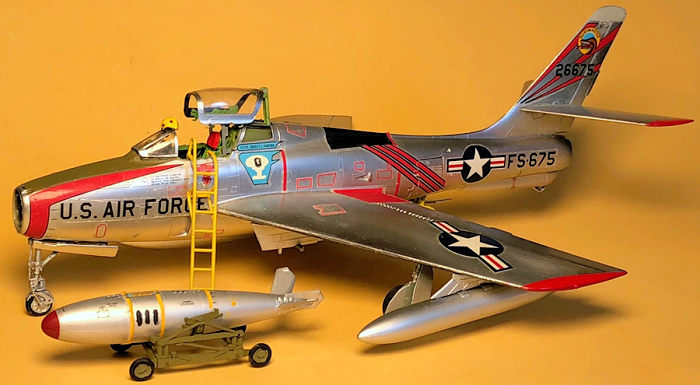 most USAF aircraft wore during the Vietnam War. The
next year, Monogram re-released kit no. 5437, which included a Mark 7 nuclear
weapon, a JATO unit and a weapon’s cart (the cart was also a part of the
original kit, but the Mark 7 was not).
most USAF aircraft wore during the Vietnam War. The
next year, Monogram re-released kit no. 5437, which included a Mark 7 nuclear
weapon, a JATO unit and a weapon’s cart (the cart was also a part of the
original kit, but the Mark 7 was not).
The kit had raised panel lines and decent cockpit and other details. The kit consists of around 85 parts molded in silver plastic and another 5 parts that are clear plastic. There are optional parts for a raised and closed canopy.
The Monogram instructions are very adequate and include 29 steps to complete the kit. The decals, like those in many of these eighties Monogram kits, are also very good and stood up well over thirty years of time in my basement kit stash.
| CONSTRUCTION |
 The first two steps
involve assembly of the ejection seat and the cockpit tub. I sprayed the tub
chromate green – which I custom-mixed using inexpensive yellow and blue artist
acrylic paints from Hobby Lobby (I ran out of Testors enamel Chromate Green,
which I think they have stopped making) - and after assembly, I hand painted the
cockpit details with artist acrylics.
The first two steps
involve assembly of the ejection seat and the cockpit tub. I sprayed the tub
chromate green – which I custom-mixed using inexpensive yellow and blue artist
acrylic paints from Hobby Lobby (I ran out of Testors enamel Chromate Green,
which I think they have stopped making) - and after assembly, I hand painted the
cockpit details with artist acrylics.
The next step was to glue the cockpit tub and the front wheel well/air intake into the right fuselage half. I decided at this point to add weight to the front of the model so I would not have to use the included tail support part. Note that there is plenty of room for lead weights, BBs, etc. I then moved to the rear of the right fuselage, assembled the jet engine tailpipe, and glued it and the fuel dump into the fuselage.
At this point, I glued the two fuselage halves together, and they fit fairly well. I only had to use a small amount of filler to make the seams look right.
I glued the upper and lower wing pieces together and then glued them to the fuselage. The wings have offset tabs (two on each wing) that make alignment with the proper dihedral pretty easy.
I then assembled the main and nose gear, which is quite delicate, requiring some caution during assembly. I sprayed these Testors aluminum once completed and set them aside. I also painted the insides of the wheel wells at this time with my home brew chromate green. I decide to close the speed brakes, so I skipped step 17 and glued the speed brake doors to the fuselage.
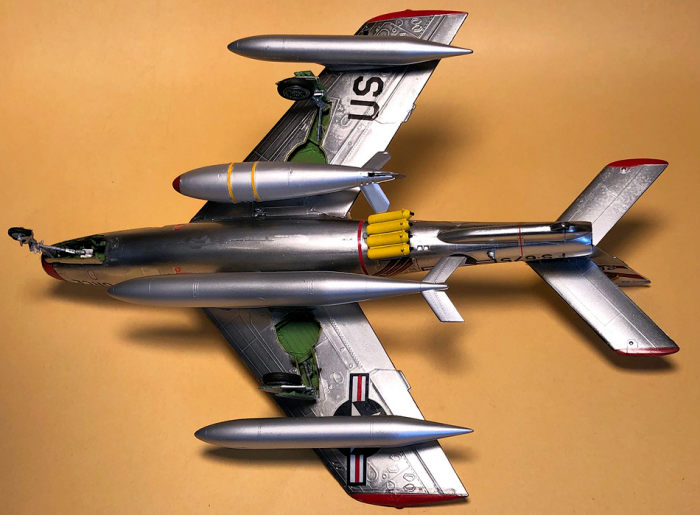 I assembled the drop
tanks and their wing pylons. Since I was choosing to display the aircraft with
the Mark 7 weapon, there were only three drop tanks to assemble (in fact, the
kit only contains one of the inner drop tanks. At one time, I was going to build
the kit without the nuke, so I had an extra drop tank from another kit, but,
alas, I did not need it).
I assembled the drop
tanks and their wing pylons. Since I was choosing to display the aircraft with
the Mark 7 weapon, there were only three drop tanks to assemble (in fact, the
kit only contains one of the inner drop tanks. At one time, I was going to build
the kit without the nuke, so I had an extra drop tank from another kit, but,
alas, I did not need it).
At this stage, I was still unsure if I really wanted to use the nuclear weapon included in the kit, so I went online and started looking up what nuclear weapons were carried by the F-84F. Low and behold, I found that the F-84 Thuderstreak carried the Mark 7 nuclear bomb, and I found several pictures of the weapon at various sites, including a picture of one on display beside an F-84F at the National Museum of the Air Force. Amazingly, the bomb included in the Monogram kit is a pretty good likeness of the real weapon, so I was now inclined to use it. The only modification I made to the kit’s bomb was to cut a notch in the rear of the bomb and, using the picture as a reference, I glued the top stabilizer fin in its folded position. Per the photo, I painted the bomb aluminum with a light maroon nose tip, which I replicated with Testors Model Master British Crimson paint.
| COLORS & MARKINGS |
I was now ready to paint the aircraft. After masking the canopy and temporarily gluing it to the fuselage with white glue, I sprayed the entire aircraft with Al Clad Chrome. After finishing, I decided the model was way too shiny for an operational aircraft, so I toned down the chrome with Testors Glosscote. I later decided it needed more toning down, so I lightly over-sprayed the entire model with Testors Dullcote.
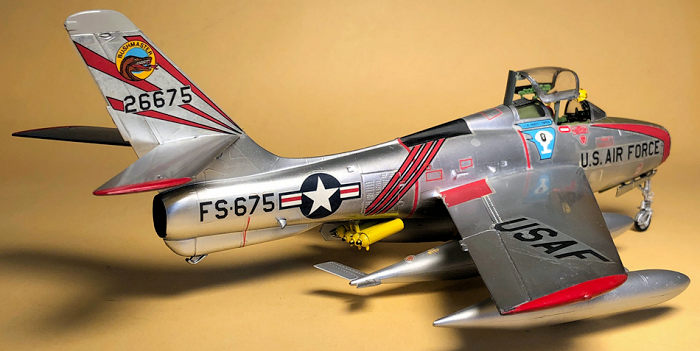 I applied the kit decals
to the aircraft and the bomb. For the bomb, I found some stenciling from my
decal “scrap heap” that resembled the stenciling on the museum bomb example and
applied these. I then sprayed a light coat of Dullcote over the bomb. I also
found some yellow stenciling for the bomb cart.
I applied the kit decals
to the aircraft and the bomb. For the bomb, I found some stenciling from my
decal “scrap heap” that resembled the stenciling on the museum bomb example and
applied these. I then sprayed a light coat of Dullcote over the bomb. I also
found some yellow stenciling for the bomb cart.
I painted the kit’s JATO bottles bright yellow per the kit instructions, although pictures I found on the internet showed these to be white. I then glued the JATO package to the underside of the fuselage.
As a final touch, I had an old painted flight helmet in my collection of parts, made by cutting off the head of a pilot figure and then hollowing out the helmet. I had previously painted it yellow and applied some very small star decals to give it that “personalized flight helmet” look of the early years. I then white glued this on the front windscreen. I also added an old boarding ladder that I had.
| CONCLUSIONS |
Another great Monogram kit from the eighties. And, again, considering they were around $8 in the eighties and you can now find them on Ebay for $10-15, these kits are a real bargain. I highly recommend these Monogram kits to all modelers!
| REFERENCES |
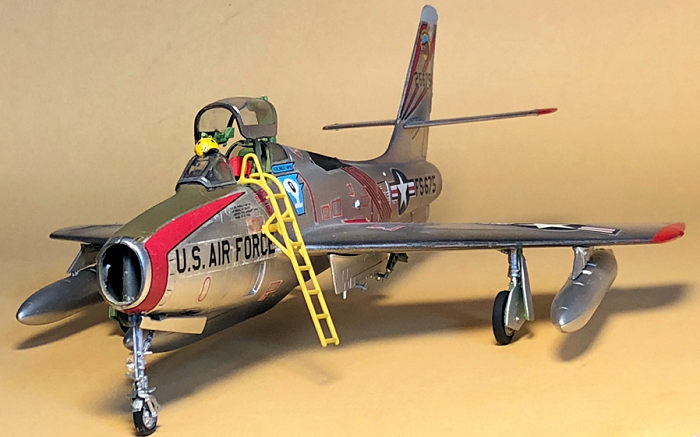 1. “Republic F-84F Thunderstreak,” Wikipedia, October
2019
1. “Republic F-84F Thunderstreak,” Wikipedia, October
2019
2. “Mark 7 Nuclear Bomb,” Wikipedia, October 2019
3. Rocket, Ali, “Two Former Langley Bomber Pilots Recount One of the Base’s Worst Accidents,” Daily Press, September 23, 2015.
14 January 2020
Copyright ModelingMadness.com
If you would like your product reviewed fairly and fairly quickly, please contact the editor or see other details in the Note to Contributors.
Back to the Main Page Back to the Review Index Page Back to the Previews Index Page